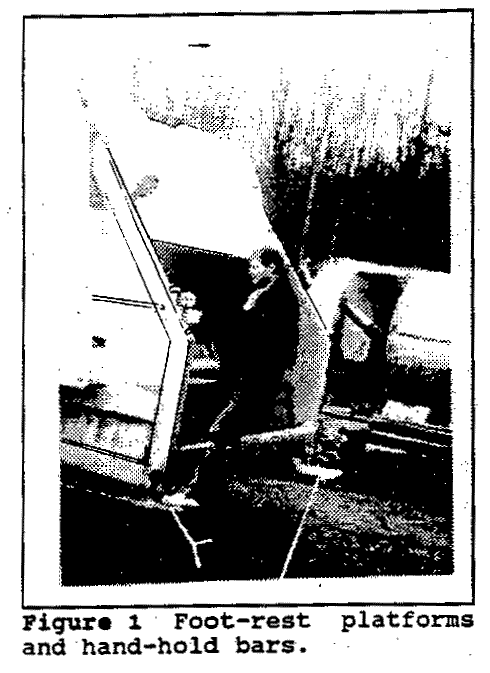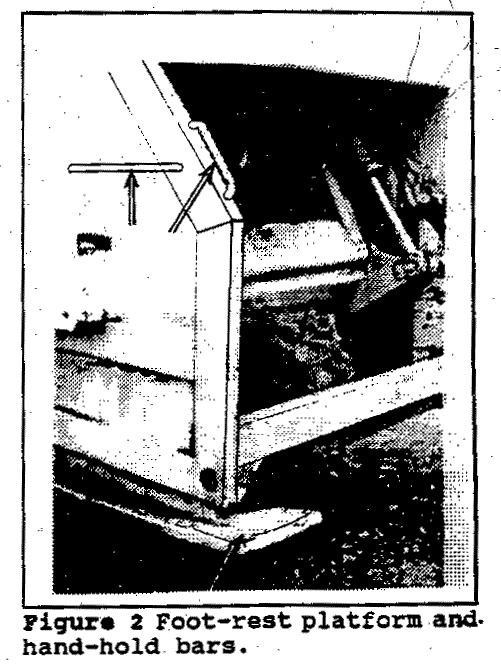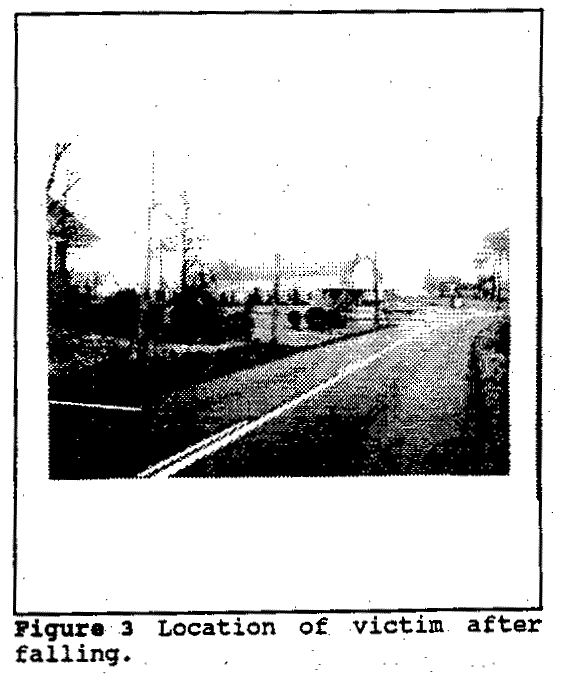County Garbage Collector Dies After Falling From Back End of Moving Garbage Truck
FACE 9109
SUMMARY
A 44-year-old male county garbage collector (victim) died after falling from the back end of a moving garbage truck. The victim, another garbage collector (co-worker), and the driver of the garbage truck were following a routine collection route, picking up bags of leaves. After picking up several bags at a business, the workers drove toward another pickup site about ½ mile away. Since the victim was feeling nauseated, he decided to ride on the back end of the truck to get some fresh air. The driver and co-worker rode inside the cab of the truck. While the truck was traveling about 35 miles per hour along a rural highway, the victim, who was standing on a footrest platform and holding onto a handhold bar, lost his balance and fell 12 inches to the pavement. The victim died of head injuries sustained in the fall. NIOSH investigators concluded that, in order to prevent future similar occurrences, employers should:
- ensure that garbage collectors remain inside vehicles with fastened seat belts, while traveling to and from collection areas
- ensure that workers do not perform potentially hazardous tasks when their ability to work safely becomes impaired
- ensure that garbage collectors wear approved protective helmets while on the job
- provide training and implement comprehensive safe work procedures that specifically address jobsite hazards.
INTRODUCTION
On November 29, 1990, a 44-year-old male county garbage collector (victim) died after falling 12 inches from the back end of a moving garbage truck. On December 6, 1990, officials of the Virginia Occupational Safety and Health Administration notified the Division of Safety Research (DSR) of the death and requested technical assistance. On January 16, 1991, a research industrial hygienist from DSR traveled to the incident site and conducted an investigation. The DSR investigator reviewed the incident with the county solid waste sanitation department, the medical examiner, the police department, and the Virginia OSHA compliance officer assigned to the case. Photographs of the incident site were obtained during the investigation.
The employer in this incident is a county solid waste sanitation department that has been in operation for 23 years. Currently, the department employs 33 garbage collectors and 12 garbage truck drivers. The county has a general written safety policy. The individual county departments conduct their own specific safety programs. The solid waste sanitation department has a written safety program, including some general instructions and safety procedures for garbage collectors and garbage truck drivers. The director of the solid waste sanitation department is responsible for implementing and enforcing the safety program for the department. Garbage collectors and garbage truck drivers attend monthly safety meetings where general safety issues are discussed. Supervisors and co-workers provide on- the-job safety training to newly hired garbage collectors. The solid waste sanitation department hired the victim, who had no previous work experience as a garbage collector, 3 weeks before the incident occurred. He had received on-the-job safety training, but the department had not conducted a safety meeting since his date of employment. The department requires garbage collectors to wear the personal protective equipment (PPE) issued to them. The PPE consists of an industrial protective helmet (ANSI-approved, suspension-type hard hat with chin strap), gloves, safety goggles, steel-toe boots, and an orange safety vest.
INVESTIGATION
The employer assigned a garbage collection crew a routine collection route in a rural area of the county. The crew consisted of a garbage truck driver, and two garbage collectors (victim and co-worker). The crew arrived at the garbage truck compound at 8:30 a.m. to begin their assigned task of picking up bagged leaves. The crew left the compound in a 25-cubic yard, rear-end loading and compacting garbage truck.
The victim and co-worker rode inside the truck cab to the designated pickup area, as required by department procedures. As they made pickups within these areas, the victim and co- worker stood on footrest platforms (measuring 12 inches by 8 inches) at the rear left and right ends of the truck (Figures 1 & 2). The platforms are 12 inches above the ground level, and have a surface consisting of a steel, machine-punched serrated grating. There are two handhold bars located about 4 feet above each platform. One handhold bar is welded horizontally on the side of the truck and the other is welded vertically on the back of the truck (Figures 1 & 2). On the day of the incident, the co-worker was wearing a hard hat. The victim was not wearing a hard hat because the department had not yet issued him one.
At 12:00 p.m. the workers stopped at a convenience store for lunch. The victim bought a hot dog that, according to the co-worker, “looked bad.” The co-worker advised the victim that he should not eat it, but he ate it anyway. About 1 hour later, the victim mentioned to the co-worker and truck driver that he felt like vomiting. The co-worker and driver asked the victim to ride in the cab of the truck (next to the window) to the next pickup location, about ½ mile away. The victim refused, stating that he would ride on the back end of the truck for the “fresh air.” The co-worker climbed into the cab with the driver, and the victim got on the back end of the truck.
The truck was traveling about 35 miles per hour (MPH) toward the next pickup location, along a road with a posted speed limit of 55 MPH. The victim was standing on the footrest platform at the left back end of the garbage truck, with both hands holding onto the vertical bar.
According to a police report, at 1:30 p.m. another vehicle (a van) was following about 50 yards behind the garbage truck. The van driver and his passenger saw the victim convulse, and then fall to the left of the platform. The truck driver looked in his left rear view mirror and saw the victim fall off the truck. When the victim hit the pavement he tumbled to a stop on the left hand side of the road (Figure 3).
The truck driver stopped the garbage truck immediately and rushed to the unconscious victim. The van driver stopped nearby, then ran to a residence and called the local emergency medical service (EMS). The truck driver and co-worker covered the victim with a coat and waited until police and EMS rescue personnel arrived. EMS rescue personnel arrived in about 6 minutes, and transported the victim to a local hospital. The attending physician pronounced him dead 5 hours later.
CAUSE OF DEATH
The medical examiner listed severe head and brain injuries with skull fracture and cerebral contusions and lacerations as the cause of death.
RECOMMENDATIONS/DISCUSSION
Recommendation #1: Employers should ensure that garbage collectors ride inside the cab of the collection vehicle (or a separate transport vehicle) with secured seat belts, while traveling to and from collection areas.
Discussion: Garbage collectors should only ride on the back end of trucks (standing on designated footrest platforms) when making pickups between adjoining residences and businesses. According to written safety instructions by the county solid waste sanitation department, “Employees may ride on the back of the truck between collections (i.e. between houses). In any traveling not involving collections, such as to and from service center or to and from landfill, the employees will be ferried by designated solid waste personnel. Upon leaving designated collection routes, crews may not ride on the back of the vehicle to and from drop off points located more than 2 – 3 blocks from route.” According to consensus standards from the National Safety Council, and the French National Technical Committee (“Public Employee Safety Guide, Refuse Collection” and “Urban Solid Waste Collection Operations: Accident Prevention,” respectively), these safety instructions reflect standard operating procedures.
Recommendation #2: Employers should ensure that workers do not perform potentially hazardous tasks when their ability to work safely becomes impaired.
Discussion: Garbage collectors are exposed to a variety of potential safety and health hazards. Any acute illness occurring on the job can impair the garbage collector’s ability to work safely. According to accepted procedures and guidelines for solid waste collection operations, employers should instruct solid waste collection workers to immediately report (to their supervisors) any illness, or symptoms of illness, that could affect their safety while on the job. Supervisors can then take appropriate measures to ensure that workers who become ill on the job are properly attended. Many garbage collection trucks have two-way radios located inside the cab, enabling prompt reporting of such information to supervisors. (In this incident, there was a two-way radio inside the cab of the truck, but it was not working.)
Recommendation #3: Employers should ensure that garbage collectors wear approved protective helmets while on the job.
Discussion: Employees working under conditions where there is a possible danger of head injury from impact, or from falling or flying objects, should wear protective helmets. While OSHA has no legal jurisdiction over public employers, such as county solid waste sanitation departments, the OSHA General Industry and Construction Standards (29 CFR 1910.135 and 29 CFR 1926.100) serve as appropriate guidelines in this instance, especially concerning head protection. Protective helmets should meet specifications outlined in ANSI Standard Z89.1-1986, “Personnel Protection – Protective Headwear for Industrial Workers – Requirements.” Protective helmets that meet the ANSI Standard provide impact attenuation (including the impact from some types of falls) by limiting the magnitude and concentration of impact forces. Currently, there are industrial protective helmets available that can provide a degree of head protection for falls of less than 10 feet.
Recommendation #4: Employers should provide training and implement comprehensive safe work procedures that specifically address jobsite hazards.
Discussion: The application of OSHA Standard 29 CFR 1926.21(b)(2) as a guideline is appropriate in this instance. It states, “The employer shall instruct each employee in the recognition and avoidance of unsafe conditions and the regulations applicable to his work environment to control or eliminate any hazards or other exposure to illness or injury.” Garbage collectors should be trained in specific safe work procedures pertaining to all aspects of their work.
REFERENCES
National Safety Council, Public Employee Safety Guide, Refuse Collection, Chicago, Illinois, 1974.
French National Technical Committee, Urban Solid Waste Collection Operations: Accident Prevention, Hamilton, Ontario, Canada, February 1986.
Office of the Federal Register, Code of Federal Regulations, Labor, 29 CFR Part 1910.135, 29 CFR Part 1926.100, and 29 CFR Part 1926.21(b)(2), U.S. Department of Labor, Occupational Safety and Health Administration, Washington, D.C., July 1989.
American National Standards Institute, Inc., Z89.1-1986, Personnel Protection – Protective Headwear for Industrial Workers – Requirements, December 1986.



